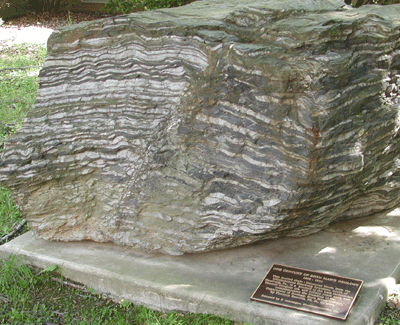|
|
Meta/phor
I've heard the word
Metamorphosis
bandied about when McBrides talk;
butterflies, cocoons, and the like.
Having spent some time with rocks
I'd say metamorphism, not metamorphosis
is the better story.
To make a metamorphic rock
(well, there are a few paths, but here is one),
take a rock (a shale perhaps, a mudstone)
and leave it where continents collide.
Bury it. Heat it. Fold. Flatten.
Apply pressure and stresses
(compressional, tensional, deviatoric).
And the rock changes.
It has to.
Too much stress too fast, it'll break
(cataclasis).
Too much heat--it melts.
But when conditions are ripe, just short of destruction,
The mud becomes mica; garnets emerge, blue-bladed kyanite:
The shale becomes schist.
No silken cocooning, no quiet emergence,
no mere cosmetic change, no, but a shift down to its very chemistry.
Atom by atom, the rock responds, its history rewritten
in its crystal lattice.
And after a few tens of millions of years
(an eon, an epoch)
our rock reemerges,
with the geological equivalent of a little wisdom and a few gray hairs.
(And these are the rocks dozing under the campus;
these are the walls of Taylor and Thomas,
the slow giant hearts of the Appalachians.)
And when you hold it in your hand,
and if you know how to read a rock,
then what you'll see is this: What it was. Where it's been. What fires
it's seen.
So what I have to say is this:
if you're looking for a metaphor, and the topic is McBrides,
forget butterflies.
Think rocks. Andrea Friedman, 01
April, 2002
Sediment Core
The geologist says
a sediment core
is
like a drinking straw stuck down through a layer cake, yes,
like a straw through a layer cake; it is a twenty-foot-long
four-inch-diameter clear plastic tube plunged vertically
through the ocean floor and then retrieved, yes,
providing a continuous record of sedimentation and erosion,
allowing for interpretation of geological events that occurred at a
single location
over time, over millions of years, yes, millions of years;
the youngest sediments are at the top of the core,
and they get older and older the lower you go;
it is like a straw through a layer cake, yes,
a straw though a layer cake....
And I say
a sediment core
is
a diary read in reverse
is
my pile of old jeans: size 10, size 8, size 6
is
a stack of letters from former lovers
is
old house wallpaper, peeling, layer on layer
is
a page of Talmud
is
an hour with a really good shrink
is
a long answer to the right question
is
unbuttoning her gray silk blouse
is
the poem I wrote this morning.
Andrea Friedman
The Atlantic Twin, Manasquan Inlet, NJ
May 9, 2002
|
|




